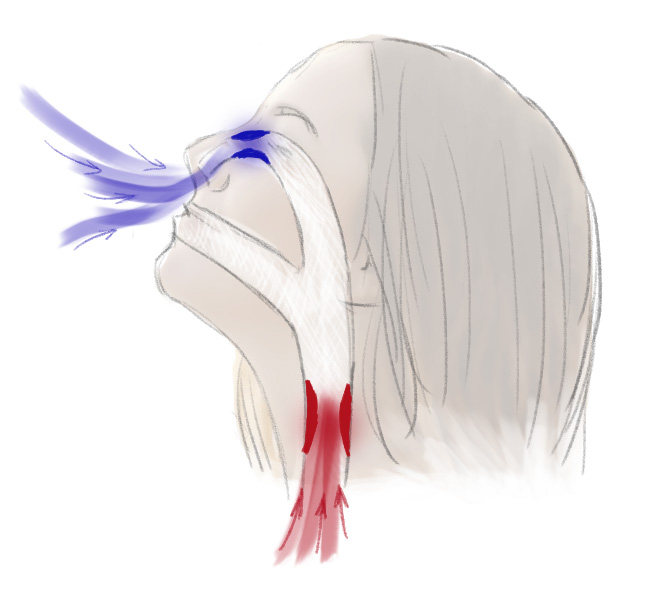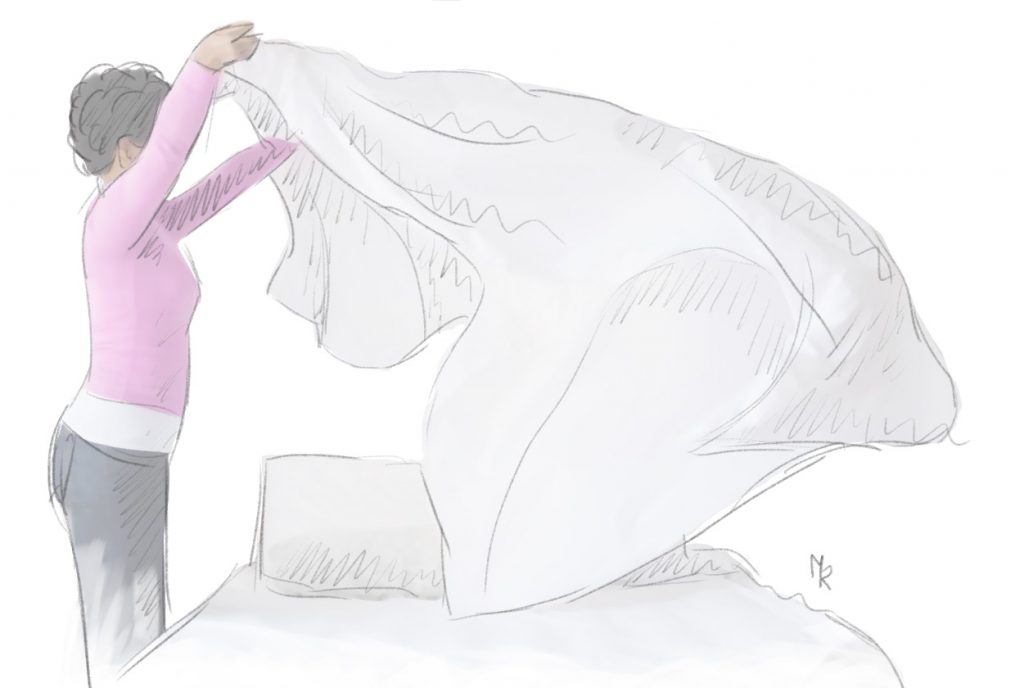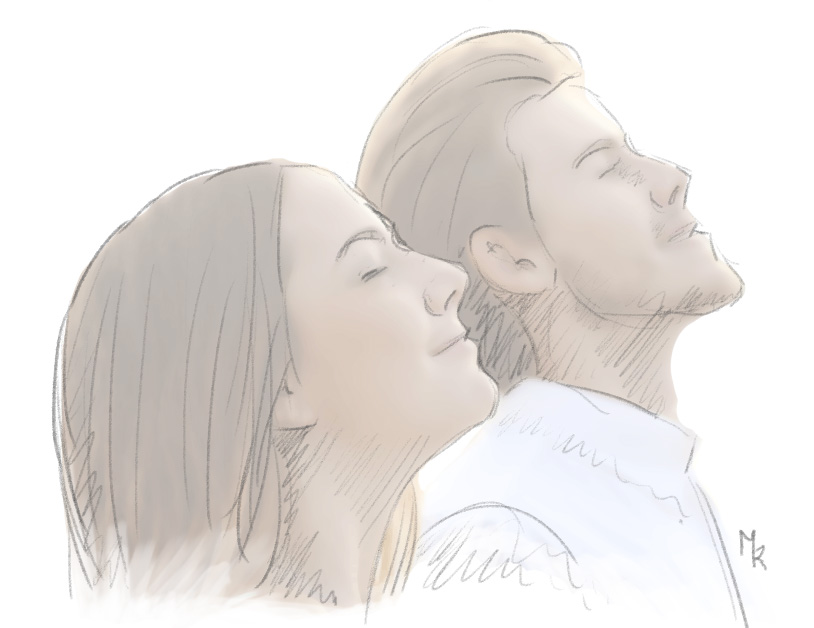There are an infinite number of ways to keep our monkey mind under control. All rely on observing something and watching it closely.
Following the breath is the simplest form of meditation there is. It’s the simplest way to entertain your monkey, and it’s the core of Buddhist meditations.
Some breathing methods are complex and involve holding your breath, breathing in for a certain count, holding, breathing out for a count, breathing in through different nostrils etc. But simply following the breath is the key to building awareness and focus.
In my mind (my ego), simpler is better. There’s less to worry about, less to get hung up on. Less to go wrong.
How do you follow the breath? What does that mean exactly?
You need to choose a place in your body to observe the breath.
If you belly breathe, you can feel the diaphragm moving quite easily. You’ll feel the muscle move and simply observe those sensations as your abdomen rises and falls. You’re either feeling the skin stretching and relaxing or you’re feeling your belly press against clothing.
The nose is a really good place to observe the breath. The air usually feels cool as it moves in, so you can observe that cool burning sensation in the bridge of your nose. The out breath is a little more difficult to follow because the air is heated to your body temperature, so you don’t get that same cool sensation. Also, as your breathing slows down, the sensations in the nose drop off and become less distinct and more difficult to focus on.
Throat. If you slightly constrict your throat, you can make a little raspy noise each time you breathe. This works just as well for the in-breath as well as the out-breath, so is quite good for beginners. The downside is that it does create muscle tension in the throat, so that counters the whole muscle relaxation thing.

I very often start my meditation by focusing on the cool in-breath in the nose and watching the hiss of a constricted throat on the out breath. As my breathing slows down, I relax the throat completely and focus on something more subtle. But don’t worry about that for now.
Chest. If you naturally chest breathe, you can feel the chest rising and falling. Either the stretching of the skin or the rubbing against your shirt. This also drops off as your breathing slows so may become more difficult as you get more relaxed.
Nose, throat, chest and abdomen are all really great places to start. Just pick one and stick with it for a while. Maybe a week before trying one of the others if you don’t seem to be having any success.

Making the bed
Here’s an extra little trick that will supercharge your meditation.
This is a “Gregarious Hermit”, patent pending breathing method. It actually combines a slight visualization technique too, but it really helps keep the focus on the breathing more easily.
So you know when you’re putting a bed sheet on the bed and you waft it in the air, how it just seems to hang in the air momentarily before dropping. Well, as you breathe in, imagine wafting a super lightweight sheet that just gently hangs in the air at the top of your breath. For a brief moment it hangs weightless.
Notice your breath at this point and you’ll notice that it’s perfectly still. Perfectly calm. That’s a glimpse of the stillness that you’re aiming for in meditation.

So, the patent pending method, gets you to focus on the “Not Breathing” part of the breath, which for me, shuts my mind down much faster. I’m a visual person, so visualizing the bed sheet really works well for me. Might not do anything for you, but it’s definitely worth a shot.
Ultimately, you want to go beyond observing the breath and observing nothing, so learning to observe the NOT breath puts you well on the way.

So why do we focus on the breath?
Almost all functions in our body are completely subconscious. We can’t speed up our heart or tell our gall bladder to produce more bile. We can’t make our hair grow faster.
But with breathing, we can consciously hold our breath and we can consciously breath faster, shallower, deeper etc. However, when we forget to do it consciously, our subconscious takes over and does it for us without even needing to think.

So breathing is the only function in the body that bridges the conscious and subconscious mind.
Breathing doesn’t form a memory. We don’t remember past breaths.
“Oh, I remember when I was 14, I did a really amazing breath. It was so awesome.”
Or, “you should have seen me last weekend, I had such a mellow breath. It was transcendental maaaaaaan. You should have been there.”
And as far as I know, we don’t plan future breaths.
“I can’t wait for this weekend. I’m going to have some wonderful breaths on Saturday afternoon.”
We don’t remember our previous breath and we don’t plan our next breath.
Breathing is always now. Always PRESENT.
So we can use it as an anchor to keep us coming back to the PRESENT.
Remember, the mind always works in the past and the future, but never in the present.
Wise Hermit
So if you can remain focused on your breathing, you are always “PRESENT” and essentially shut out the mind.
When your mind drags you off into a story, your breathing will bring you back. Just be gentle. Don’t kick yourself for not being good at meditation. Your mind is just doing what your mind does. Just gently go back to watching the breath and meditation will just happen.
Meditation Boot Camp – Quick Navigation
- Meditation Roots – the history of meditation
- Why Meditate? – why do we need to meditate
- Physical Relaxation – the importance of physical relaxation for meditation
- Meditation Environment – how to set up the perfect environment for meditation
- Best Meditation Posture – different meditation postures that work for everyone
- Breathe Properly – both energize and relax your body by breathing properly
- Breathing Practice – simple breathing exercise before meditating
- Subtle Sensations – becoming aware of your body
- Stop the Mind – stopping the mind from chattering
- Entertain the Monkey – giving the mind a task during meditation
- Follow the Breath – focusing on breathing during meditation
- Simple Breathing Meditation – putting it all together in meditation
- Meditation is a Journey – make meditation a lifelong practice